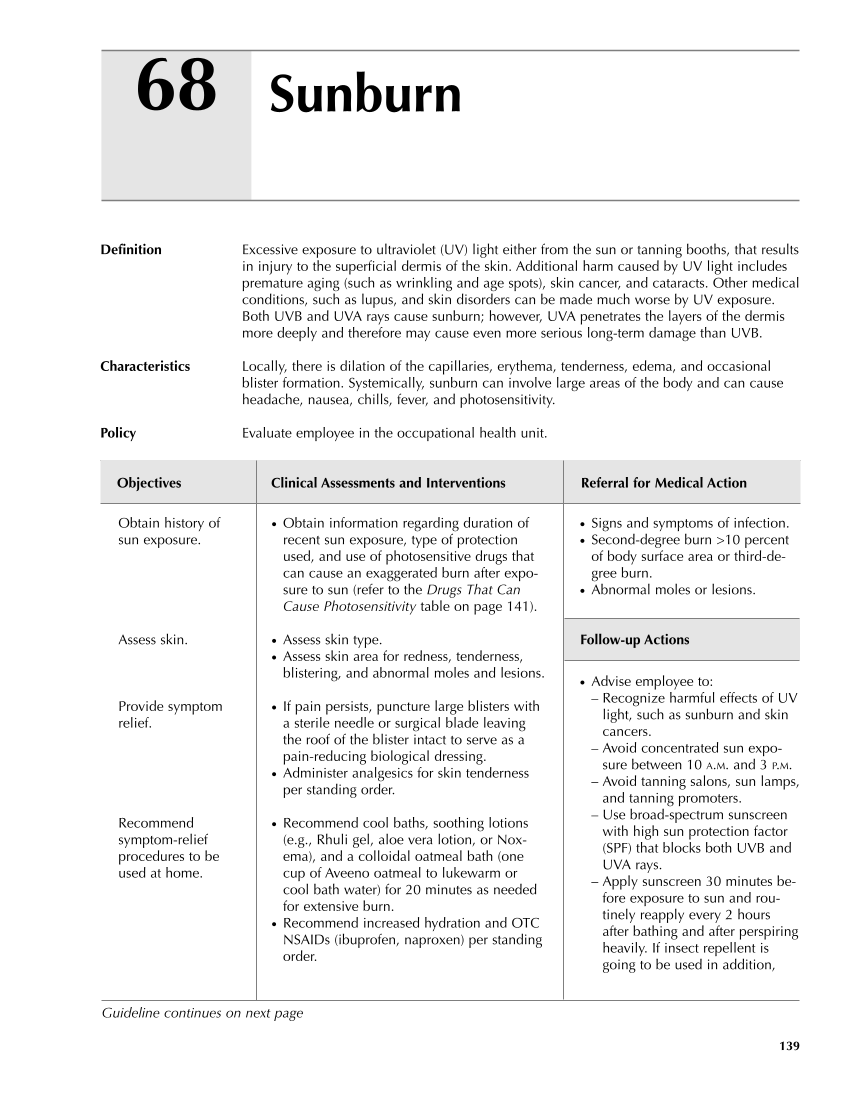139 Sunburn 68 Definition Excessive exposure to ultraviolet (UV) light either from the sun or tanning booths, that results in injury to the superficial dermis of the skin. Additional harm caused by UV light includes premature aging (such as wrinkling and age spots), skin cancer, and cataracts. Other medical conditions, such as lupus, and skin disorders can be made much worse by UV exposure. Both UVB and UVA rays cause sunburn however, UVA penetrates the layers of the dermis more deeply and therefore may cause even more serious long-term damage than UVB. Characteristics Locally, there is dilation of the capillaries, erythema, tenderness, edema, and occasional blister formation. Systemically, sunburn can involve large areas of the body and can cause headache, nausea, chills, fever, and photosensitivity. Policy Evaluate employee in the occupational health unit. Objectives Clinical Assessments and Interventions Referral for Medical Action ● Signs and symptoms of infection. ● Second-degree burn 10 percent of body surface area or third-de- gree burn. ● Abnormal moles or lesions. Follow-up Actions ● Advise employee to: – Recognize harmful effects of UV light, such as sunburn and skin cancers. – Avoid concentrated sun expo- sure between 10 A.M. and 3 P.M. – Avoid tanning salons, sun lamps, and tanning promoters. – Use broad-spectrum sunscreen with high sun protection factor (SPF) that blocks both UVB and UVA rays. – Apply sunscreen 30 minutes be- fore exposure to sun and rou- tinely reapply every 2 hours after bathing and after perspiring heavily. If insect repellent is going to be used in addition, Obtain history of sun exposure. Assess skin. Provide symptom relief. Recommend symptom-relief procedures to be used at home. ● Obtain information regarding duration of recent sun exposure, type of protection used, and use of photosensitive drugs that can cause an exaggerated burn after expo- sure to sun (refer to the Drugs That Can Cause Photosensitivity table on page 141). ● Assess skin type. ● Assess skin area for redness, tenderness, blistering, and abnormal moles and lesions. ● If pain persists, puncture large blisters with a sterile needle or surgical blade leaving the roof of the blister intact to serve as a pain-reducing biological dressing. ● Administer analgesics for skin tenderness per standing order. ● Recommend cool baths, soothing lotions (e.g., Rhuli gel, aloe vera lotion, or Nox- ema), and a colloidal oatmeal bath (one cup of Aveeno oatmeal to lukewarm or cool bath water) for 20 minutes as needed for extensive burn. ● Recommend increased hydration and OTC NSAIDs (ibuprofen, naproxen) per standing order. Guideline continues on next page
Purchased from OEM Press by (ge corporate access). (C) 2013 OEM Health Information, Inc. All rights reserved.












































































































































































































































































































































































































































